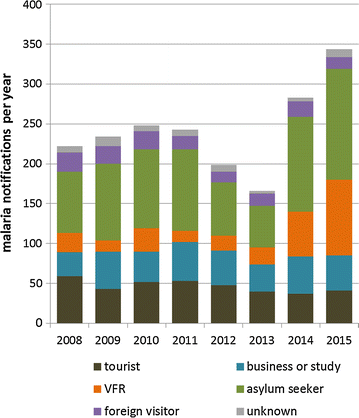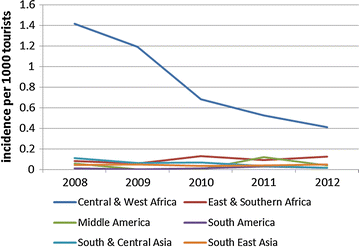Increase in imported malaria in the Netherlands in asylum seekers and VFR travellers
- PMID: 28148300
- PMCID: PMC5288937
- DOI: 10.1186/s12936-017-1711-5
Increase in imported malaria in the Netherlands in asylum seekers and VFR travellers
Abstract
Background: Malaria is a notifiable disease in the Netherlands, a non-endemic country. Imported malaria infections occur regularly among travellers, migrants and visitors. Surveillance data were analysed from 2008 to 2015. Trends in amounts of notifications among risk groups were analysed using Poisson regression. For asylum seekers, yearly incidence was calculated per region of origin, using national asylum request statistics as denominator data. For tourists, denominator data were used from travel statistics to estimate incidence per travel region up to 2012.
Results: A modest increase in overall imported malaria notifications occurred in 2008-2015 (from 222 in 2008 to 344 in 2015). Notably, in 2014 and 2015 sharp increases were seen in malaria among travellers visiting friends and relatives (VFR), and in asylum seekers. Of all Plasmodium falciparum infections, most (1254/1337; 93.8%) were imported from Africa; 1037/1337 (77.6%) were imported from Central and West Africa. Malaria in VFR was mostly caused by P. falciparum infection after visiting Ghana (22%) or Nigeria (19%). Malaria in asylum seekers was mostly caused by Plasmodium vivax infection from the Horn of Africa. The large number of notifications in asylum seekers resulted from both an increase in number of asylum seekers and a striking increase of malaria incidence in this group. Incidence of malaria in asylum seekers from the Horn of Africa ranged between 0.02 and 0.3% in 2008-2013, but rose to 1.6% in 2014 and 1.3% in 2015. In 2008-2012, incidence in tourists visiting Central and West Africa dropped markedly.
Conclusions: Imported malaria is on the rise again in the Netherlands, most notably since 2013. This is mostly due to immigration of asylum seekers from the Horn of Africa. The predominance of P. vivax infection among asylum seekers warrants vigilance in health workers when a migrant presents with fever, as relapses of this type of malaria can occur long after arrival in the Netherlands.
Keywords: Epidemiology; Surveillance; Travel.
Figures
Similar articles
-
Imported cases of malaria in Spain: observational study using nationally reported statistics and surveillance data, 2002-2015.Malar J. 2019 Jul 10;18(1):230. doi: 10.1186/s12936-019-2863-2. Malar J. 2019. PMID: 31291951 Free PMC article.
-
Declining incidence of imported malaria in the Netherlands, 2000-2007.Malar J. 2010 Oct 28;9:300. doi: 10.1186/1475-2875-9-300. Malar J. 2010. PMID: 21029424 Free PMC article.
-
Imported malaria in Spain (2009-2016): results from the +REDIVI Collaborative Network.Malar J. 2017 Oct 10;16(1):407. doi: 10.1186/s12936-017-2057-8. Malar J. 2017. PMID: 29017499 Free PMC article.
-
Malaria: still a threat to travellers.Int J Antimicrob Agents. 2003 Feb;21(2):158-63. doi: 10.1016/s0924-8579(02)00367-9. Int J Antimicrob Agents. 2003. PMID: 12615380 Review.
-
Review of infectious diseases in refugees and asylum seekers-current status and going forward.Public Health Rev. 2017 Sep 8;38:22. doi: 10.1186/s40985-017-0065-4. eCollection 2017. Public Health Rev. 2017. PMID: 29450094 Free PMC article. Review.
Cited by
-
Evidence of malarial chemoprophylaxis among travellers who died from malaria: a systematic review and meta-analysis.Malar J. 2023 Nov 25;22(1):359. doi: 10.1186/s12936-023-04794-x. Malar J. 2023. PMID: 38001503 Free PMC article.
-
Multiplex real-time PCR for diagnosing malaria in a non-endemic setting: a prospective comparison to conventional methods.Eur J Clin Microbiol Infect Dis. 2018 Dec;37(12):2323-2329. doi: 10.1007/s10096-018-3378-4. Epub 2018 Sep 26. Eur J Clin Microbiol Infect Dis. 2018. PMID: 30259214
-
Malaria in Eritrean migrants newly arrived in seven European countries, 2011 to 2016.Euro Surveill. 2019 Jan;24(5):1800139. doi: 10.2807/1560-7917.ES.2019.24.5.1800139. Euro Surveill. 2019. PMID: 30722809 Free PMC article.
-
Malaria Surveillance - United States, 2017.MMWR Surveill Summ. 2021 Mar 19;70(2):1-35. doi: 10.15585/mmwr.ss7002a1. MMWR Surveill Summ. 2021. PMID: 33735166 Free PMC article.
-
Area of exposure and treatment challenges of malaria in Eritrean migrants: a GeoSentinel analysis.Malar J. 2018 Nov 29;17(1):443. doi: 10.1186/s12936-018-2586-9. Malar J. 2018. PMID: 30497487 Free PMC article.
References
-
- WHO. World Malaria Report 2015. Geneva: World Health Organization; 2015.
-
- Dutch Tourist Board and NIPO Research. Continuous Holiday survey; 2008–2013.
-
- Composition of macro geographical (continental) regions, geographical sub-regions, and selected economic and other groupings.: United Nations Statistics Division. http://unstats.un.org/unsd/methods/m49/m49regin.htm.
MeSH terms
LinkOut - more resources
Full Text Sources
Other Literature Sources
Medical




